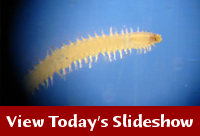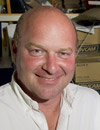You Feed Me, I Feed You: Symbiosis
Some animals in the ocean have developed a special relationship with each other that helps ensure the survival of both organisms. In most cases, the pair includes a microbe and a host animal. The microbes provide their host animal with food and the host provides the microbes with either some of the things they need to survive or a home—often both. Learn more »
|
  Today's Weather Mostly sunny Lat: 28° 40' Long: -88° 28' Air temp: 52°F ( 11°C) Water temp: 73.6°F ( 23.1°C) Barometric pressure: 1014 mbar Seas: 8-10 feet Wind: WNW, 30 mph Go Ahead, Play in the MudDecember 12, 2010 (posted December 13, 2010) They may not be as colorful as the coral samples or as exotic as the tubeworms, but the sediment cores that come off Alvin’s sample basket last are probably the real stars of this trip. That’s right, sediment. Mud from the bottom of the ocean. “I think mud is very glamorous,” said Amanda Demopoulos, a scientist with the U.S. Geological Survey, whom we jokingly call the “Mud Queen.” She’s a crucial player in what we hope to accomplish on this cruise. By looking at the mud, Amanda and her colleagues can help bring together a story that encompasses the oil, the corals, and the rest of the deep sea. Amanda and Janessy Frometta are on the cruise to study the tiny organisms that live in the upper 10 centimeters (4 inches) of the muddy ocean floor. Tiny as they are, these animals play a big role in the deep-sea ecosystem. With Helen White, a geochemist who studies the impact of oil spills in the coastal ocean, they hope to clarify our understanding of how the oil spill might affect the marine environment as a whole. “The fact that we’re all working together to tell a complete story is key to this cruise,” said Amanda. “It’s not something any one of us could do working alone.” Much of the sediment on the bottom of the ocean is formed by detritus—tiny pieces of dead plants and animals and bits of inorganic material such as shell fragments, which fall slowly down from the surface and pile up on the seafloor over thousands or millions of years. This slow rain of material acts as food for other animals in the ocean. If those particles came from an sea surface with an oil slick or fell through oil in the depths, it is possible that the sediment and the organisms that live there will show the first signs of impact from the spill. Sediment corers work much like apple corers; they are inserted into seafloor and pulled out with a plug of mud. When the heavy cores come off Alvin’s basket they are lugged into the Atlantis “wet lab” just forward of Alvin’s hangar. There, Amanda and her team of increasingly muddy helpers begin slowly removing the sediment from the clear plastic tubes, photographing and documenting everything as they go. Some of the cores will be analyzed by a lab back on shore for traces of hydrocarbons and for the unique chemical “fingerprint” of oil from Deepwater Horizon. But that’s not our job. Our job on this cruise is to examine the interaction between oil (any oil) and the seafloor of the Gulf. Our initial findings still need more thought and more analysis, but they are surprising. Instead of seeing many live animals in the top section of sediment as she ordinarily does, Amanda is seeing more dead creatures than normal. Today, they also found several pieces of detritus with something that Helen could only call “oil-like in color.” Saying anything more would be speculation, not science. Together, Helen and Amanda create a powerful team. Amanda has studied hundreds of sediment samples from around the Gulf of Mexico. She knows mud. Helen has studied oil spills and their impact on coastal wetlands for the past decade. She knows oil in the environment. They are joined by Ken Halanych, who will take samples of the cores back to his lab at Auburn University to study the genetic material from anything living in the sediment. Then he and Amanda can compare notes to determine the diversity (different types of animals) and abundance (total number of animals) in the sediment. Even if no oil from the spill is found in the cores, there is still a lot to be learned from them. They will tell us about the general health of the food chain here in the Gulf of Mexico and what the larger, flashier animals have available to eat. It’s also just a good excuse to play in the mud. When All Else Fails Atlantis might appear to be just our ride out here, but it is also a powerful research instrument in and of itself. On the bottom of the ship’s hull is something called a multibeam sonar system. With this, Atlantis can map the bottom of the ocean with high-frequency sound. The maps it produces aren’t as accurate as those from Sentry because Sentry flies very close to the bottom, but it is extremely helpful in identifying large features on the seafloor that might be worth a closer look with an underwater vehicle such as Sentry. The only problem is, we have to sail in a pattern of precisely spaced straight lines instead of pointing the front of the ship into the wind and waiting for the weather to clear. That made a rough day even rougher and we had to strap everything down—including my laptop, which has a bungee cord holding it down to the workbench where I write. The movement of the ship also made it difficult to write for another reason: motion sickness. When your body’s two main ways for detecting motion (your eyes and inner ears) don’t sense the same amount or direction of motion, your body gets confused. The result is usually nausea. That’s a bit oversimplified, but generally how it works. I’ve never been seasick before, but I’ve never had to wedge myself into place and type on a computer for several hours while the room I’m writing in gets pushed around by 20-foot waves. By early last night, I was feeling a little queasy, so I went up to the bridge to talk to third mate Kami Bucholz and able seaman Jim McGill, who were on watch last night. Up there, the motion is actually worse because any rolling motion is magnified the further you get from the center of the ship. Being able to see the horizon move allowed my brain to make sense of the motion that my inner ears were feeling. It was also an amazing sight—towering waves would appear out of the darkness an instant before the ship’s bow would plow into them, sending white spray flying as high as the windows on the bridge. It might sound odd, but after that, I was able to sleep much better.
Read the new Hot Topic Read the new Interview  Tim Shank: Deep-sea corals form the foundation of a diverse and spectacular collection of biodiversity, yet they are very poorly understood. Tim Shank studies these ecosystems and the relationship between corals and associates, the animals that live among the corals. Read the interview » Tim Shank: Deep-sea corals form the foundation of a diverse and spectacular collection of biodiversity, yet they are very poorly understood. Tim Shank studies these ecosystems and the relationship between corals and associates, the animals that live among the corals. Read the interview »
[ Previous update ] [ Next update ]
|
||
Mailing List | Feedback | Glossary | For Teachers | About Us | Contact
© 2010 Dive and Discover™. Dive and Discover™ is a registered trademark of Woods
Hole Oceanographic Institution




